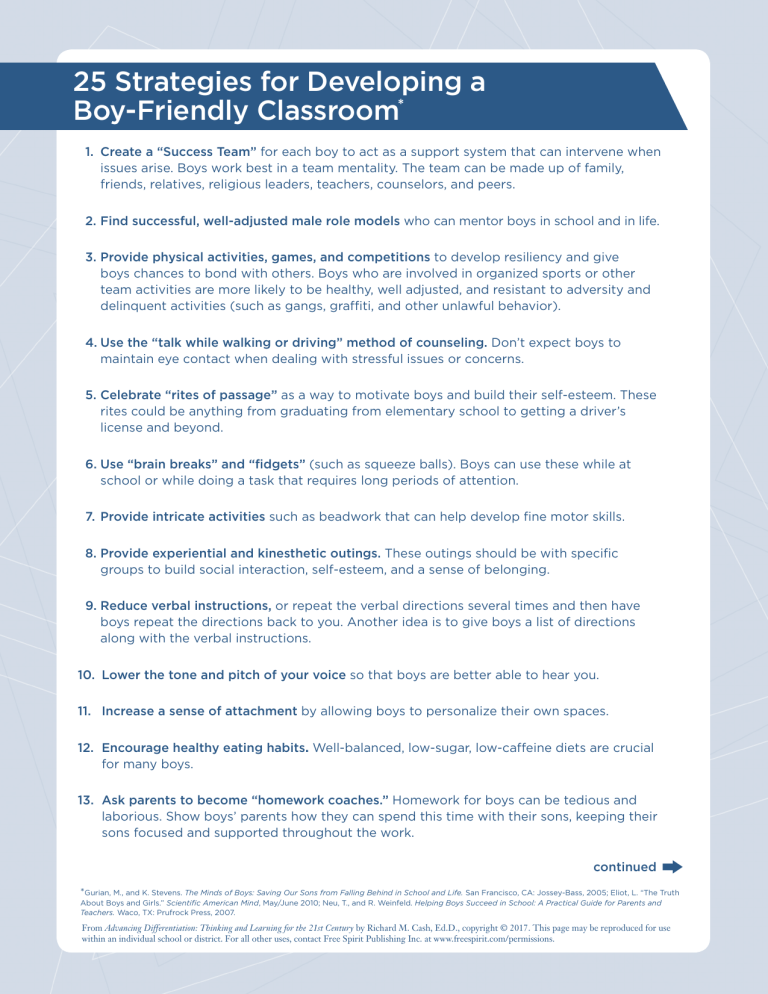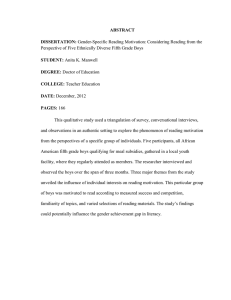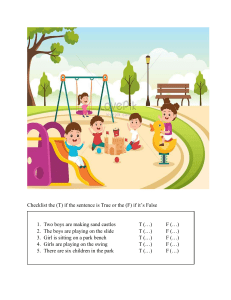
25 Strategies for Developing a Boy-Friendly Classroom* 1. Create a “Success Team” for each boy to act as a support system that can intervene when issues arise. Boys work best in a team mentality. The team can be made up of family, friends, relatives, religious leaders, teachers, counselors, and peers. 2. Find successful, well-adjusted male role models who can mentor boys in school and in life. 3. Provide physical activities, games, and competitions to develop resiliency and give boys chances to bond with others. Boys who are involved in organized sports or other team activities are more likely to be healthy, well adjusted, and resistant to adversity and delinquent activities (such as gangs, graffiti, and other unlawful behavior). 4. Use the “talk while walking or driving” method of counseling. Don’t expect boys to maintain eye contact when dealing with stressful issues or concerns. 5. Celebrate “rites of passage” as a way to motivate boys and build their self-esteem. These rites could be anything from graduating from elementary school to getting a driver’s license and beyond. 6. Use “brain breaks” and “fidgets” (such as squeeze balls). Boys can use these while at school or while doing a task that requires long periods of attention. 7. Provide intricate activities such as beadwork that can help develop fine motor skills. 8. Provide experiential and kinesthetic outings. These outings should be with specific groups to build social interaction, self-esteem, and a sense of belonging. 9. Reduce verbal instructions, or repeat the verbal directions several times and then have boys repeat the directions back to you. Another idea is to give boys a list of directions along with the verbal instructions. 10. Lower the tone and pitch of your voice so that boys are better able to hear you. 11. Increase a sense of attachment by allowing boys to personalize their own spaces. 12. Encourage healthy eating habits. Well-balanced, low-sugar, low-caffeine diets are crucial for many boys. 13. Ask parents to become “homework coaches.” Homework for boys can be tedious and laborious. Show boys’ parents how they can spend this time with their sons, keeping their sons focused and supported throughout the work. continued *Gurian, M., and K. Stevens. The Minds of Boys: Saving Our Sons from Falling Behind in School and Life. San Francisco, CA: Jossey-Bass, 2005; Eliot, L. “The Truth About Boys and Girls.” Scientific American Mind, May/June 2010; Neu, T., and R. Weinfeld. Helping Boys Succeed in School: A Practical Guide for Parents and Teachers. Waco, TX: Prufrock Press, 2007. From Advancing Differentiation: Thinking and Learning for the 21st Century by Richard M. Cash, Ed.D., copyright © 2017. This page may be reproduced for use within an individual school or district. For all other uses, contact Free Spirit Publishing Inc. at www.freespirit.com/permissions. 25 Strategies for Developing a Boy-Friendly Classroom (continued) 14. Consider brain injury when faced with a learning disability. During rough play at an early age, some boys may have experienced a brain injury, which may not have been diagnosed and could lead to later learning problems. 15. Place books around the classroom to encourage boys to read. 16. Set up “Boys Only” book clubs to bridge the gap in academic language acquisition and break down the stigma of reading being a feminine activity. Use literature as a way of shaping identity and forming social groups. 17. Offer boy-friendly reading choices, which may include action, gore, fun, and purposeful adventures. These types of choices can often be found in comic books, graphic novels, magazines, cartoon anthologies, or “How Things Work” books. 18. Provide plenty of technological outlets to stimulate creativity. Computer graphics and screen animations are excellent ways to engage boys in research and investigations. 19. Limit screen time. While computer time is highly beneficial for boys, it must be monitored and used in moderation. Also encourage parents to limit the amount of television or other media their boys consume. 20. Focus curriculum and instruction on the self. Adolescence, particularly for boys, is a period of egocentric development. Focusing the content on how boys fit within the topics will engage and encourage them to participate more completely. 21. Make learning experiences meaningful, rigorous, and active. Boys are often more physically active than girls. Therefore, by making the learning more authentic and active, boys will have a better chance of engaging in the tasks. 22. Provide opportunities for safe risk taking. The competitive nature of boys may stunt their intellectual risk taking. Ensure that your classroom is free of intimidation and is supportive when mistakes happen. 23. Allow for choices. When boys (particularly adolescent boys) don’t have power within a situation, they will often rebel and are less likely to participate in the learning activities. 24. Use bright natural light for reading. Boys are generally more visually stimulated than girls. 25. Use stories to encourage social cohesion, build empathy, transmit knowledge, persuade, challenge, and develop boys’ social acumen. *Gurian, M., and K. Stevens. The Minds of Boys: Saving Our Sons from Falling Behind in School and Life. San Francisco, CA: Jossey-Bass, 2005; Eliot, L. “The Truth About Boys and Girls.” Scientific American Mind, May/June 2010; Neu, T., and R. Weinfeld. Helping Boys Succeed in School: A Practical Guide for Parents and Teachers. Waco, TX: Prufrock Press, 2007. From Advancing Differentiation: Thinking and Learning for the 21st Century by Richard M. Cash, Ed.D., copyright © 2017. This page may be reproduced for use within an individual school or district. For all other uses, contact Free Spirit Publishing Inc. at www.freespirit.com/permissions.



